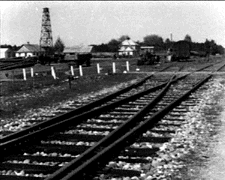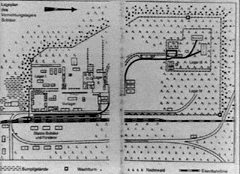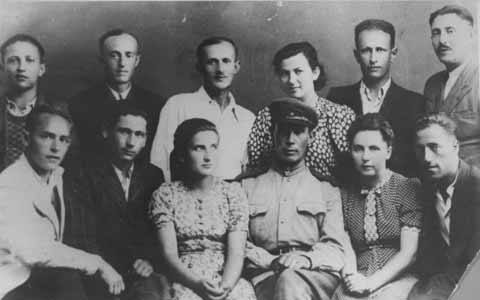History & Overview
The second extermination
camp to come into operation through the Nazi “Operation Reinhard”, the extermination camp at Sobibor was established
March 1942. Its first commandant, Franz Stangl, presided over about 700 Jewish workers
engaged temporarily to service the camp, however this number would soon grow exponentially. "Operation" at Sobibor lasted from April 1942 until the camp was destroyed following an inmate revolt in October 1943. Approximately 250,000 people were murdered here, the vast majority being Jews.
 Railroad to Sobibor Death Camp
Railroad to Sobibor Death Camp |
Sobibor actually consisted of two
camps which were divided into three parts: administration section; barracks and storage; and
finally the extermination, burial, and cremation
section. Initially, three gas chambers housed in a brick building
using carbon monoxide and three more gas chambers were added later.
Located in a sparsely populated area of Poland so as not to attract much outside attention, Sobibor was strategically placed also in
relation to the concentrations of Jews in the Polish cities of Chelm and Lublin. The planners were
able to incorporate the experience already gained from constructing the Belzec concentration camp, and the Nazi's used local Polish workers and Jewish slave laborers
to build the camp.
The site measured roughly 1,300 by
2,000 feet, surrounded by a triple line of barbed wire fencing and
guarded by watchtowers, and was sub-divided into two camps with a reception area that included the spur line and platform
which could accommodate up to 20 railroad wagons.
The first camp held the
Jewish prisoners required to service the SS men and Ukrainians.
Enroute to the second camp from the platform where buildings were the
deportees left their luggage and clothing. Within the second camp was
an enclosed area, entirely shielded by tree branches intertwined with
the barbed wire, where deportees undressed in the open before
proceeding up a fenced in passageway called `the tube1 towards the
shaving hut for women and the gas chambers. Also in camp two were
storage huts for clothing and valuables.
The third camp was the most remote
area and was screened by trees. Inside was the brick building housing
three gas chambers, about 12 feet by 12 feet, each of which could
hold about 160-180 people. Carbon monoxide generated by a diesel
engine mounted outside was piped into the gas chambers. The corpses
were removed from a second door and buried in huge, specially
excavated pits. Carts, and later trolleys on a small rail track, were
used to carry deportees who were too infirm to walk to the burial
pits where they were shot so as not to delay the killing process.
 Map of Sobibor Death Camp
Map of Sobibor Death Camp |
In April 1942, Franz Stangl, an SS
officer with a background in Operation T4, arrived to take command.
Stangl commanded a mere 20-30 SS men, mainly from the T4 program.
There was also a guard company of Ukrainians. About 200 to 300 Jews
worked in teams at the gas chambers and burial pits. They cleaned out
the killing rooms, removed gold teeth from the corpses and pushed
trolleys heaped with bodies towards the pits. About 1,000 Jews worked
at the platform cleaning up the rail trucks and removing debris, and
in teams at the shaving hut, the undressing barracks and in the
sorting sheds.
From May 1942 to July 1942,
approximately 100,000 Jews were murdered at Sobibor. They came from
Lublin, Czechoslovakia, Germany and Austria (mostly via ghettos in
Poland or Theresienstadt). They
were told on arrival that they had arrived at a `transit camp1. The
platform and adjacent building was designed to reassure them. They
were then separated according to gender and age: children went with
the women. They were divested of their luggage and valuables, forced
to undress and driven up `the tube1, men first, to the gas chambers.
Women were shaved at a hut situated along `the tube1. The actual
killing process took about 20-30 minutes. The `processing1 of a
convoy of 20 wagons took about 2-3 hours.
Between August and September 1942,
the murdering stopped while repairs were made to the main rail track
feeding Sobibor, and the number of gas chambers was increased to six,
three on either side of a central corridor. This enabled the SS to
kill about 1,200 people at the same time. The bodies were burned in
the former burial pits. The camp, now under the command of Franz
Reichsleiter, continued operations in October 1942 and worked through
to spring 1943.
 Group portrait of people who took part in the
uprising of Sobibor (picture taken in 1944)
Group portrait of people who took part in the
uprising of Sobibor (picture taken in 1944) |
Over this period, about 70-80,000
Galician Jews, 145-150,000 Jews from the General-Government and
25,000 Slovak Jews were murdered. In March 1943 the first transport
of French Jews arrived. Between March and July 1943, 19 Dutch
transports brought 35,000 Jews from Holland. In the last months of
its operation, Sobibor was used to murder the Jews of the Vilna,
Minsk, and Lida ghettos. It is estimated that 250,000 Jews were
murdered at Sobibor.
In July 1943, Himmler, who had
visited the camp in February, ordered that it be converted into a
concentration camp. This edict effectively served a death notice on
the Jewish workers who then organized a resistance movement and
worked out an escape plan. It was led by Leon Feldhendler.
He was subsequently
assisted by Alexander Pechersky, a Jewish officer in a transport of
Red Army POWs which arrived in the camp in September 1943. The
uprising was launched on October 14, 1943. In the fighting, 11 SS men
and a number of Ukrainian guards were killed. Three hundred Jews
escaped, but dozens were killed in the mine field around the camp and
dozens more were hunted down over subsequent days.
Following the revolt, the camp was liquidated
in October 1943 and the site demolished and disguised as a farm. The Nazi's also planted hundred of trees over the area.
The number of survivors of Sobibor is still unknown and varies in different sources. Yad Vashem says about 50 of the Jews who escaped during the uprising survived. Another source cited by the US Holocaust Memorial Museum says the number was 47. As of March 2014, four remained alive.
In 2001, researchers, archaeologists, and historians in Poland began excavating the Sobibor site in hopes of finding more clues about the camp and those killed within its fences. Over the next six years little useful information was found, however, in 2007, Israeli archaeologist Yoram Haimi joined the investigation after he learned that two of his uncles had been murdered at the camp.
By August 2012, Haimi and his team of workers had uncovered numerous artifacts believed to have been the last possessions of some prisoners. Amid the teeth, bone shards and ashes through which he has sifted, he has recovered jewelry, keys and coins that have helped identify some of Sobibor’s formerly nameless victims. One finding inclduded an engraved metal identification tag bearing the name of Lea Judith de la Penha, a 6-year-old Jewish girl from Holland who Israel’s Yad Vashem Holocaust memorial confirmed was murdered at the camp. “The Germans didn’t discriminate. They killed little girls too,” Haimi said in reference to the finding.
Haimi's most important discovery, however, has led to a better understanding of the entire Sobibor site. Based on debris collected and patterns in the soil, he has also been able to figure out where the Nazis placed poles to hold up the camp’s barbed wire fences. That, in turn, led him to his major breakthrough - the mapping of what the Germans called the Himmelfahrsstrasse, or the “Road to Heaven,” a path upon which the prisoners were marched naked into the gas chambers. He determined its route by the poles that marked the path. From that, he determined where the gas chambers would have been located.
While far from finished in his research or excavation, Haimi understands the importance of uncovering more truth about the Holocaust, especially when the generation of survivors is quickly dwindling. “Because of the lack of information about Sobibor, every little piece of information is significant,” said Haimi. “No one knew where the gas chambers were. The Germans didn’t want anyone to find out what was there. But thanks to what we have done, they didn’t succeed.”
In January 2014, Haimi and his Polish colleague, Wojciech Mazurekm, uncovered nine open-air cremation pits and a cabin that housed Jews whom the Nazis exploited for slave labor. About five feet below the cabin floor, they unearthed a man-made tunnel that led to the barbed wire around the camp - most likely used as an escape route.
An archeological dig concluded in September 2014 further revealed the twisted history of the Sobibor camp, as gas chambers where a quarter of a million Jews perished were uncovered. This discovery is the culmination of 8 years of archeological excavation and exploration around the area of the death camp. The camp had to be excavated because when the Nazis deserted it, they covered all of their tracks and levelled most of the camp. Nothing but a forest and a concrete monument marked the Sobibor camp after it was deserted. In addition to uncovering the buildings of the camp, archeologists have also uncovered numerous personal artifacts stolen and thrown away by the Nazis including rings, coins from Palestine, perfume bottles, and Magen David necklaces. A visitor center commemorating the Jewish lives lost is to be built on the grounds after the excavation and analysis is complete. The excavation is being sponsored by Yad Vashem's International Institute for Holocaust Research, the German-Polish Foundation, and the Majdanek State Museum.
Sources: The
Forgotten Camps (Photos from USHMM); "Israeli Archaeologist Digs Up Past at Infamous Sobibor Death Camp," Washington Post, (August 21, 2012).; "New excavations shed light on Sobibor death camp," Israel Hayom, (January 27, 2014); “Sobibor, ” Yad Vashem; Jules Schelvis, “Sobibor: A History of a Nazi Death Camp,” USHMM; Wesley Pruden, “The last living witnesses; they wore the yellow star and remember the Nazi terror,” Washington Times, (December 12, 2013); Reuters, September 18 2014
|